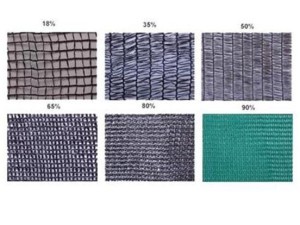[:es]Definamos primero que es una malla de sombreo.
Es un geotextil formado por bandaletas de rafia de polietileno de alta densidad (HDPE) y monofilamento de PE y tejida mediante el método Raschel.
Debe estar estabilizada a los rayos UV y debe ser imputrescible al 100%
A la hora de poner una malla de sombreo que proteja eficazmente a nuestro cultivo, hay que tener en cuenta entre otros muchos factores la orientación, la dirección del viento y el tipo de cultivo que tenemos, pero entre todos estos deberemos valorar básicamente dos consideraciones:
*Color
*Porcentaje de sombreo
Color
Actualmente en el mercado existe todo un abanico de colores de mallas, rojos, azules, negros, verdes, blancos, aluminizada, etc.
Normalmente, y para un porcentaje de sombreo igual, el comportamiento según el color varia un poco.
– Negra: Es el color que más sombreo proporciona y a la vez es el más natural, produce una disminución en la luminosidad y una disminución de la temperatura.
– Blanca: Este color reduce el calor sin quitar luminosidad, está indicada para plantas que requieran una gran cantidad de luz o cultivos con gran densidad.
– Verde: Proporciona un sombreo ligeramente superior a la malla blanca e inferior a la negra. Se aconseja cuando no se quiera un gran impacto visual.
– Aluminio: Esta es interesante cuando se necesita pantalla térmica, es decir reducción de insolación y de pérdida calorífica nocturna.
– Otros colores: No son representativos en el mercado.
Porcentaje de sombreo
Se entiende por porcentaje de sombreo a la reducción de insolación cuando los rayos solares inciden perpendicularmente sobre la superficie.
Una malla del 80% significa, que cuando el sol incida perpendicularmente, la malla dejará pasar el 20% de la energía lumínica y calorífica.
A la hora de elegir un porcentaje de sombreo, aparte de la orientación, tenemos que tener en cuenta la ventilación, una malla muy cerrada impedirá la correcta ventilación, con la consecuente subida de temperatura.
[:en]First of all we are going to make a definition of what is a sun shade screen.
It is a geotextile consisting on raffia strip of high density polyethylene (HDPE) and PE monofilament woven by the Raschel method.
It must be UV stabilized and should be 100% rot-proofs.
We have to take into account several factors before choosing the suitable sun shade screen such as position, wind direction and the type of crop we have. Nevertheless, we basically have to consider these two things:
*Colour
*Grade of shade
Colour
They are in the market at the moment a wide range of sun colour shades: red, blue, black, green, white, etc.
We are going to focus on the most significant.
–Black: It is the colour that offers more shade and the most natural too, provides a decrement in luminosity and in temperature.
–White: This colour reduces the heat without removing luminosity; it is indicated for plants which required a large amount of light or high density crops.
–Green: It provides a slightly higher shadow than the white and lower than the black. It is recommended when you do not need a deep visual impact.
–Aluminium: That is interesting when you need thermal shield, that is to say to reduce insolation and nocturnal heat loss.
– Other colours: They are not representative in the market.
Grade of shade
It is understood by grade of shade the insolation reduction when solar rays have a vertically impact on the surface.
So an 80% sun shade screen means that when the sun falls vertically, the sun shade screen would allow passing the 20% of light and heat energy.
When you think about what grade of shade to choose, apart from direction, we should also consider ventilation. A closed sun shade will not allow the correct ventilation; consequently it would be a rise in temperature.



